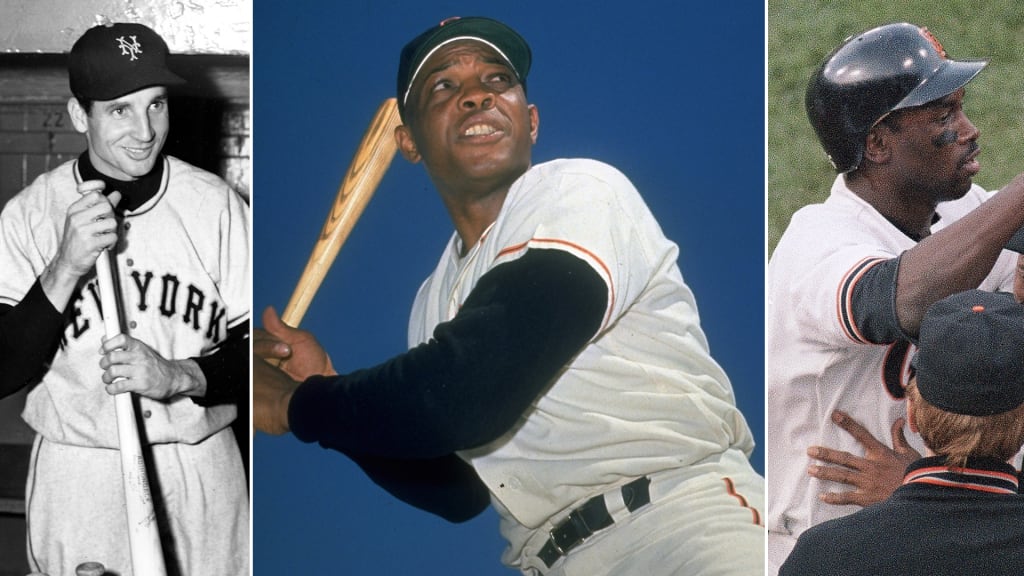
No one loves a good debate quite like baseball fans. With that in mind, we asked each of our beat reporters to rank the top five players by position in the history of their franchise, based on their career while playing for that club. These rankings are for fun and debate purposes only. We also asked fans to weigh in on Twitter:
Here is Maria Guardado’s ranking of the top five center fielders in Giants history. Next week: Right fielders.
1) Willie Mays, 1951-72
Key fact: Inducted into the Hall of Fame in 1979
Widely regarded as the best all-around player in baseball history, Mays was a singular talent who spent 21 of his 22 Major League seasons with the Giants, serving as the most prominent bridge between the New York and San Francisco eras. The Say Hey Kid won two National League MVP Awards, appeared in 24 All-Star Games and captured 12 Gold Glove Awards while captivating generations of baseball fans over his Hall of Fame career. Mays hit .302 with 660 home runs, 1,903 RBIs and 3,283 hits over his career and holds the all-time record for putouts by an outfielder, with 7,095.
"If somebody came up and hit .450, stole 100 bases, and performed a miracle in the field every day, I'd still look you right in the eye and tell you that Willie was better,” Hall of Fame manager Leo Durocher wrote in his book, Nice Guys Finish Last. “He could do the five things you have to do to be a superstar: hit, hit with power, run, throw and field. And he had the other magic ingredient that turns a superstar into a super Superstar. Charisma. He lit up a room when he came in. He was a joy to be around."
Mays joined the Birmingham Barons of the Negro American League at age 16 and quickly caught the eye of the New York Giants, who purchased his contract in 1950. Mays reached the Majors the following year, but he endured a slow start as a 20-year-old rookie, going hitless in his first 12 at-bats before finally breaking through with a home run off Hall of Famer Warren Spahn. Mays never looked back, batting .274 with 20 home runs and 68 RBIs over 121 games to win the NL Rookie of the Year Award.
Mays missed most of 1952 and all of '53 while serving in the Army during the Korean War, but he returned to deliver one of his finest campaigns, leading the Giants to the NL pennant after batting a league-best .345 with 41 home runs, 13 triples and 110 RBIs.
During Game 1 of the 1954 World Series against the Indians, Mays made one of the most legendary defensive plays in baseball history. With two runners on and the game tied, 2-2, in the top of the eighth, Vic Wertz hit a towering drive an estimated 460 feet to center field at the Polo Grounds. Turning his back to the ball, Mays sprinted toward the wall and made an over-the-shoulder catch before spinning around and firing to third base to preserve the tie. The Giants went on to win the game and sweep the Indians, earning their final World Series title in New York.
Mays won his first NL MVP Award in 1954 and his second 11 years later in San Francisco. He remains the Giants’ franchise leader in games played (2,857), home runs (646), hits (3,187), at-bats (10,477) and total bases (5,907). In 2015, Mays was presented with the Presidential Medal of Freedom by President Barack Obama, making him only the fourth baseball player to receive the nation’s highest civilian honor.
2) Bobby Thomson, 1946-53, '57
Key fact: His iconic “Shot Heard ‘Round the World” lifted the Giants to the '51 NL pennant, capping a miraculous comeback against the Dodgers
Born in Glasgow, Scotland, Thomson and his family immigrated to the United States in 1926 and settled on Staten Island. Later known as the “Staten Island Scot,” Thomson signed his first contract with the New York Giants in '42, though his baseball career was put on hold after he joined the US Army Air Corps during World War II. In '46, Thomson received his discharge and returned to the Giants, making his Major League debut at age 22. Thomson spent nine seasons in New York, earning three All-Star selections while batting .277 with a 116 OPS+ and 189 home runs.
Thomson’s signature moment came during the 1951 NL pennant race, now known as the “Miracle of Coogan’s Bluff.” After trailing the Dodgers by 13 1/2 games on Aug. 11, the Giants won 37 of their final 44 regular season games to tie the Dodgers and force a three-game playoff, which ended with one of the most famous home runs in baseball history.
After splitting the first two games of the series, the Giants and Dodgers met at the Polo Grounds for the decisive contest. With the Giants trailing, 4-2, one out and two on in the bottom of the ninth, Dodgers reliever Ralph Branca surrendered a game-winning, three-run homer to Thomson, inspiring an unforgettable call by announcer Russ Hodges:
“There's a long drive. It's gonna be, I believe -- The Giants win the pennant! The Giants win the pennant! The Giants win the pennant! The Giants win the pennant! Bobby Thomson hits into the lower deck of the left-field stands! The Giants win the pennant! And they're going crazy! They're going crazy!"
Thompson’s “Shot Heard ‘Round the World” sent the Giants to the World Series, though they ended up falling to the crosstown Yankees in six games.
3) George Van Haltren, 1894-1903
Key fact: Known as a fine defensive outfielder, Van Haltren led the NL in outfield assists in 1897, 1900 and 1901
Van Haltren established himself as an elite leadoff man in the late 19th century, batting .321 with a 118 OPS+, 320 stolen bases and 976 runs scored over his 10 seasons with the Giants. A converted pitcher, Van Haltren came over from the Pirates ahead of the 1894 season and hit .331 with a career-high 105 RBIs in his debut campaign with the Giants. He enjoyed a tremendously successful run over the next seven seasons, leading the NL in triples (1895) and stolen bases (1900), though the end of his career was hastened by a devastating ankle injury he suffered in 1902.
4) Chili Davis, 1981-87
Key fact: The first Jamaican-born player to appear in a Major League game
A native of Kingston, Jamaica, Davis fell in love with baseball after his family immigrated to the United States and settled in Los Angeles in 1970. He was selected by the Giants in the 11th round of the '77 MLB Draft out of high school and developed into a switch-hitter as he climbed the Minor League ranks. Davis reached the Majors in '81 and became a regular for the Giants the following year, placing fourth in NL Rookie of the Year Award voting after batting .261 with 19 home runs and 76 RBIs over 154 games.
In 1984, Davis hit .315 with 21 home runs and 81 RBIs over 137 games to earn the first of two All-Star selections with the Giants. He spent the first seven years of his career in San Francisco before departing to sign a free-agent contract with the Angels after the '87 season.
5) Fred Snodgrass, 1908-15
Key fact: After his baseball career ended, Snodgrass moved to California, where he became the mayor of Oxnard, a banker and a rancher
Snodgrass batted .278 with a 111 OPS+ and 198 stolen bases over eight seasons with the New York Giants. While he helped the club capture three consecutive NL pennants from 1911-13, Snodgrass is best remembered for an infamous blunder.
In the decisive Game 7 of the 1912 World Series against the Red Sox, Snodgrass dropped a routine fly ball off the bat of Clyde Engle for a two-base error, opening the door for a two-run rall y that propelled Boston to the title.
"Hardly a day in my life, hardly an hour, that in some manner or other the dropping of that fly doesn't come up, even after 30 years," Snodgrass lamented in a 1940 interview.
Honorable mentions
• Brett Butler drew NL MVP Award votes in each of his three seasons with the Giants and batted .309 with 51 stolen bases in 1990.
• Andrés Torres was a member of the 2010 World Series team, and Ángel Pagán was a member of the '12 and '14 World Series teams.
